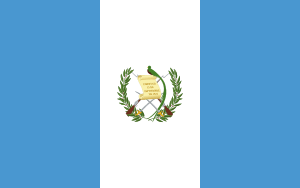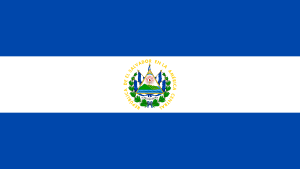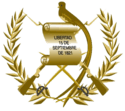Maria Cristina Vilanova
Doña María Cristina Vilanova Castro de Árbenz (17 April 1915 – 5 January 2009) was the First Lady of Guatemala from 1951-1954, as wife of the Guatemalan President Jacobo Árbenz Guzmán.[1]
María Cristina Vilanova Castro de Árbenz | |
|---|---|
.jpg) | |
| First Lady of Guatemala | |
| In role March 15, 1951 – June 27, 1954 | |
| President | Jacobo Árbenz Guzmán |
| Preceded by | Elisa Martínez Contreras |
| Succeeded by | Odilia Palomo Paíz |
| In role October 20, 1944 – March 15, 1945 Serving with Amalia Mancilla and María Leonor Saravia | |
| Leader | Jacobo Arbenz Guzmán |
| Preceded by | Judith Ramírez Prado |
| Succeeded by | Elisa Martínez Contreras |
| Personal details | |
| Born | April 17, 1915 San Salvador, El Salvador |
| Died | January 5, 2009 (aged 93) San José, Costa Rica |
| Spouse(s) | Jacobo Árbenz Guzmán |
| Children | 3 (including Arabella and Jacobo) |
Biography
Vilanova de Arbenz was born in San Salvador in 1915, where her parents belonged to the society elite. She received a privileged education in elite European institutions.[2] On a family trip to Guatemala she met the then-colonel Arbenz, and they eventually married there in 1937.[1]
Vilanova was the first wife of a Guatemalan president to attend all of his public functions, and also the first one to perform socially active work.[3] She has been often compared to Eva Perón given that she was also a feminist and had strong influence in the government during her husband's time in office.[4] She was accused, along with her husband, of sympathies to Communism,[5] and of exacting influence over him while in exile.[6]
After her husband died in 1971 in Mexico, Vilanova moved to Costa Rica with her family, where she died in 2009.[7]
Humiliation and exile
After resigning due to the coup organized by the United Fruit Company and the United States Department of State, the Árbenz Vilanova family remained for 73 days at the Mexican embassy in Guatemala, which was crowded with almost 300 exiles.[8] When they were finally allowed to leave the country, Jacobo Arbenz was publicly humiliated at the airport when the liberationist authorities made the former president strip before the cameras, claiming that he was carrying jewelry he had bought for his wife at Tiffany's in New York City, using funds from the presidency. No jewelry was found during the hour-long interrogation.[9] The Arbenz family then embarked into exile, taking them first to México, then to Canada, where they went to pick up daughter Arabella, and then on to Switzerland via the Netherlands.[10] As a condition for entry, the Swiss authorities asked Arbenz to renounce his Guatemalan nationality, to prevent the ousted president from continuing his resistance in Switzerland. Arbenz refused this request, as he felt that such a gesture would mark the end of his political career. Furthermore, he could not benefit from political asylum, because Switzerland had not yet ratified the 1951 Agreement of the newly created United Nations High Commission for Refugees, designed to protect people fleeing from communist regimes in Eastern Europe. Árbenz and his family ended up instead the victims of an intense, CIA-orchestrated defamation campaign that lasted from 1954 to the triumph of the Cuban revolution in 1959.[11] Árbenz's close friend Carlos Manuel Pellecer worked for the CIA, playing a key role in the defamation campaign.[12]
After being spurned by Switzerland, the Árbenz family moved to Paris, and then to Prague. Czechoslovak officials were uncomfortable with his stay, unsure if he would demand compensation for the poor quality of Second World War-era arms that they had sold him in 1954. After only three months, he moved again, this time to Moscow, which proved to be a relief from the harsh treatment he received in Czechoslovakia.[13] Arbenz tried several times to return to Latin America, and was finally allowed to move to Uruguay in 1957[14] (Arbenz joined the Communist Party in that year),[15] living in Montevideo from 1957 to 1960. Uruguay had been supportive throughout the Guatemalan revolutionary process, and became home to the two former presidents of the so-called Guatemalan Democratic Spring. Arbenz's predecessor, Juan José Arévalo, had been in Montevideo on several prior occasions, establishing himself there between 1958 and early 1959, when he accepted a university position in Venezuela; he expressed his views through a number of newspaper articles he penned.[16] On the other hand, Arbenz and his family, who arrived in mid-1957, had a very different experience: his communist ties, especially with José Manuel Fortuny, and forced passage through Czechoslovakia, the USSR and China, aroused suspicions.[17]
When the National Party took power in Uruguay in late 1958, the situation worsened for Arbenz there. In 1960, after the Cuban Revolution, Fidel Castro invited Árbenz to Cuba, which Árbenz Guzmán readily agreed to.
Suicide of Arabella
In October 1965, Arabella Arbenz met Mexican bullfighter Jaime Bravo Arciga, who at that time was at his peak and was about to start a tour of South America; Arabella took advantage of this and fled with him to Colombia. While in Bogotá on October 5, 1965, Arabella tried to convince Bravo Arciga not to continue as a bullfighter, fearing for his life. After an afternoon where Bravo Arciga had been gored, he went to a luxurious gentlemen's club in the Colombian capital. Arabella phoned the place pleading to talk to Bravo Arciga, but he ignored her, as he was totally inebriated and in a foul mood after the goring. Dejected, she shot herself. [18]
Bravo Arciga contacted Jorge Palmieri in Mexico via telephone, and asked him to take charge of funeral arrangements. Palmieri, who had great influence in the Mexican government at the time, obtained approval to bury Arabella in the Pantheon of the National Association of Actors of Mexico, since she had worked in an experimental film a few months earlier. Palmieri also received concessions allowing Arbenz, his wife, and children to travel to Mexico for the funeral.[19]
Arabella's death was a huge blow to both the bullfighter and Jacobo Arbenz: both would die within five years of her death.[19]
Settlement with the Guatemalan Government
In 2011, with a written agreement, the Guatemalan State recognized its international responsibility for "failing to comply with its obligation to guarantee, respect, and protect the human rights of the victims to a fair trial, to property, to equal protection before the law, and to judicial protection, which are protected in the American Convention on Human Rights and which were violated against former President Juan Jacobo Arbenz Guzman, his wife, María Cristina Vilanova, and his children, Juan Jacobo, María Leonora, and Arabella, all surnamed Arbenz Villanova."[20]
Gallery
See also




- Operation PBSuccess
- Arabella Arbenz
- Jacobo Árbenz Guzmán
Notes and references
References
- Vilanova de Arbenz 2000, p. 15.
- Vilanova de Arbenz 2000, p. 14.
- Vilanova de Arbenz 2000.
- GNWR 2006.
- Vilanova de Arbenz 2000, p. 91.
- Vilanova de Arbenz 2000, p. 90.
- Cabrera Geserick, Marco (10 October 2009). "María Vilanova de Arbenz: Un capítulo se cierra". Asociación para el Fomento de los Estudios Históricos en Centroamérica (in Spanish).CS1 maint: ref=harv (link)
- Garcia Ferreira 2008, p. 56.
- prneswire.com (October 11, 2011). "Guatemalan government issues official apology to deposed former president Jacobo Arbenz's family for Human Rights Violtions, 57 years later". Retrieved September 19, 2014.
- Garcia Ferreira 2008, p. 60.
- Garcia Ferreira 2008, p. 54.
- Garcia Ferreira 2008, p. 55.
- Garcia Ferreira 2008, p. 68.
- Koeppel 2008, p. 153.
- Gleijeses 1992, p. 379.
- Garcia Ferreira 2008, p. 70.
- Garcia Ferreira 2008, p. 69.
- Montoya n.d.
- Palmieri 2007.
- Inter-American Commission of Human Rights 2011.
Bibliography
- Cabrera Geserick, Marco (2007). Arbenz: Forbidden to Commit Suicide in Spring, A Biography. Tempe, Arizona: M.A. in History Thesis, Arizona State University.CS1 maint: ref=harv (link)
- Carpio Alfaro, I. (1996). "Memorias de Alfonso Bauer Paiz: historia no oficial de Guatemala" (in Spanish). Guatemala: Rustication Ediciones. Missing or empty
|url=(help)CS1 maint: ref=harv (link) - Cullather, Nick. Secret History: The CIA’s Classified Account of its Operations in Guatemala, 1952-1954.CS1 maint: ref=harv (link)
- Figueroa Ibarra, C. (2001). Paz Tejada, militar y revolucionario (in Spanish). Guatemala: Editorial Universitaria.CS1 maint: ref=harv (link)
- Fortuny, José Manuel (2002). Memorias de José Manuel Fortuny (in Spanish). Guatemala: Oscar de León Palacios.CS1 maint: ref=harv (link)
- García Ferreira, Roberto (2008). "The CIA and Jacobo Arbenz: The story of a disinformation campaign". Journal of Third World Studies. XXV (2).CS1 maint: ref=harv (link)
- Gleijeses, Piero (1992). Shattered hope: the Guatemalan revolution and the United States, 1944-1954. United States: Princeton University Press. ISBN 9780691025568.CS1 maint: ref=harv (link)
- Inter-American Commission of Human Rights (2011). "IACHR Satisfied with Friendly Settlement Agreement in Arbenz Case Involving Guatemala". oas.org. Retrieved 19 September 2014.CS1 maint: ref=harv (link)
- Montoya, Sofia Ann (n.d.). "A writer's journey inspired by a male muse". Ponder and dream. Retrieved September 20, 2014.CS1 maint: ref=harv (link)
- Palma, Claudia (26 June 2015). "Periquita y el suizo". Prensa Libre. Guatemala. Archived from the original on 30 June 2015. Retrieved 26 June 2015.CS1 maint: ref=harv (link)
- Mendelsohn, Alan; Pequeneza, Nadine (1999). A Coup: Made in America (Documentary Film). Barna-Alper productions and Connections Productions Resources, Inc.CS1 maint: ref=harv (link)
- Palmieri, Jorge (2007). "Arabella Arbenz Vilanova". Blog de Jorge Palmieri (in Spanish). Archived from the original on 16 January 2015. Retrieved 15 August 2014.CS1 maint: ref=harv (link)
- Pellecer, Carlos Manuel (1997). Arbenz y Yo (in Spanish). Guatemala: Artemis-Edinter.CS1 maint: ref=harv (link)
- Sierra Roldán, T. (1958). "Diálogos con el coronel Monzón: historia viva de la revolución guatemalteca, 1944-1954" (in Spanish). Guatemala: San Antonio. Missing or empty
|url=(help)CS1 maint: ref=harv (link) - Silva Girón, C.A. (1997). La Batalla de Gualán (in Spanish). Edición del Autor, Guatemala.CS1 maint: ref=harv (link)
- Vilanova de Arbenz, María Cristina (2000). Mi Esposo, el presidente Arbenz. Guatemala: Editorial Universitaria. ISBN 9789992259610.CS1 maint: ref=harv (link)
| Honorary titles | ||
|---|---|---|
| Preceded by Elisa Martínez Contreras |
First Lady of Guatemala 1951–1954 |
Succeeded by Odilia Palomo Paíz |
| Preceded by María Judith Ramírez Prado |
First Lady of Guatemala 1944–1945 |
Succeeded by Elisa Martínez Contreras |
| Party political offices | ||
| Preceded by None |
Leader of the Guatemalan Women's Alliance 1951-1954 |
Succeeded by None |
